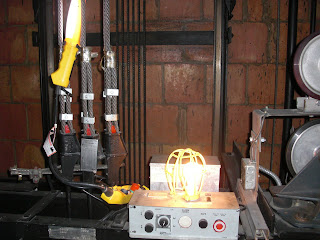Clearly, elevator technology has evolved according to the digital age's needs. The fancy new stuff is referred to as "solid state" but this old Otis "relay logic" elevator is a neat-o analog version of the machines we saw earlier. While the equipment is still functional, the elevator car is now used as a closet. According to our EM, most of the building's inhabitants don't even know that the closet is a working elevator.
This is the generator, which features many of the same components as the motors upstairs, like the copper armature and carbon brushes. The power coming into the building is AC, but the motors were DC, so the generators took that power and converted it to DC.

This is the controller. Much different than the controllers in the machine room that we saw, eh? There's a certain beauty to it, I think.

These are the old school "cards", which were hand controlled. When this system was used, you couldn't call an elevator by pressing a button in the hall. The operator had to flip the switches on this card rack.

Here's the motor:

And this is a gear. Relay logic was geared, but this building's solid state is gearless. This is like a freaking dinosaur:

The sheave:

This is a resister. It's an old transformer, which basically "steps down" power.

This is a rectifier, which also converts AC to DC:

Instead of an oil buffer, this counterweight has a spring. If a rise is over 200 feet, it requires an oil buffer, which explains why this whole get-up is outdated. That spring doesn't make me feel safe.

The counterweight:

That was a fascinating history lesson, no? Well, now it's time to jump on board car 27. And by on board, I mean, get on that shit! So, the two round things are the door operators. The I-beam with the 27 on it is the cross beam, and the black things anchoring the cables to the beam are called shackles.

You can only see a glimpse of the terror I truly felt. I could be getting leg gnawed off by wild animals, and if I saw a camera, I'd still smile. It's kind of a character defect.

Inside that gray box is the load weight device. That device tells the controller how much weight is in the car, and when it reaches a certain capacity, it won't stop for pick-up calls. That's why you'll stand waiting for an elevator forever at five o'clock. Jam-packed elevators are smarter than we are, and won't allow cramming.

The gray box with the buttons on it is the Inspection Station, which allows the mechanic to move the car while on top of it.

That top wheel is the tachometer, which counts revolutions and tells the controller exactly where the car is located. There is a corresponding tach in the motor, and the two tachs must be in synch. The bottom wheel is a roller guide, which rolls on the rails.

This is the bottom of car 28.

The side of car 28. You're seeing an old escape door--that's how you'd get rescued from a broken elevator back in the day.

Getting Shafted

Here comes the counterweight. I now know why it's called the silent killer. It scared the shit out of me. I felt like Marie Antoinette. It whooshed by me at a high rate of speed and left me with goosebumps all over my body. It was like having a shark swim silently by you, and take no notice. Brr.

There it goes...

After about ten minutes on the car, I begged for mercy. I cried 'uncle'. I waved the white flag. I emerged from the top of the car, knees a little trembly, and that concluded our tour. There was really nothing left to show me in the world of elevators. I hope you feel as educated as I do about the inner workings of a miraculous machine I usually take for granted. If you happen to take notice of an elevator mechanic doing his thing, give him or her propers for doing us all a solid--keeping us safe in the world of vertical transport.



8 comments:
uh huh huh huh rectifier
Rectify her? I don't even know her!
I've never seen resistors that big before.
...and the last time I got ontop of an elevator, there was a high rate of alcohol consumption first - never again!
(Be honest - how many lifts did you cause to be stuck between floors? C'mon, I won't tell - promise!)
Nice one - I like techie details and stories.
C
Resistor? Damn near killed her!
Costa, I was scared so shitless, if I had been drinking, I probably would have fallen into the abyss.
My elevator mechanic didn't show off by messing with the elevators. I think just having that kind of power is heady enough.
That weight-load box is really interesting. Is it an analog thing like a thermostat, or is it digital? Is it measuring the tension in the cables that hold up the elevator, like a spring scale? Or getting the weight of the load from the floor of the car somehow?
This whole "take Nora to work" concept is one of the coolest blog ideas I've ever seen, I'm psyched for the next episode.
Everything is digital. It's probably like a spring scale type situation, but I'm not sure. The equipment handbook doesn't give any information, and the EM is currently too busy to field a question, but I know where he lives ... I'll get the answers for you.
"Nora gets Shafted" Bow chicka wow wow!
Wait 'til you hear what I'm thinking about for the title when I go to work with you, Ratherto.
Let's make that happen SOON like. Even if I can't get on a barge, it would still be interesting.
Post a Comment